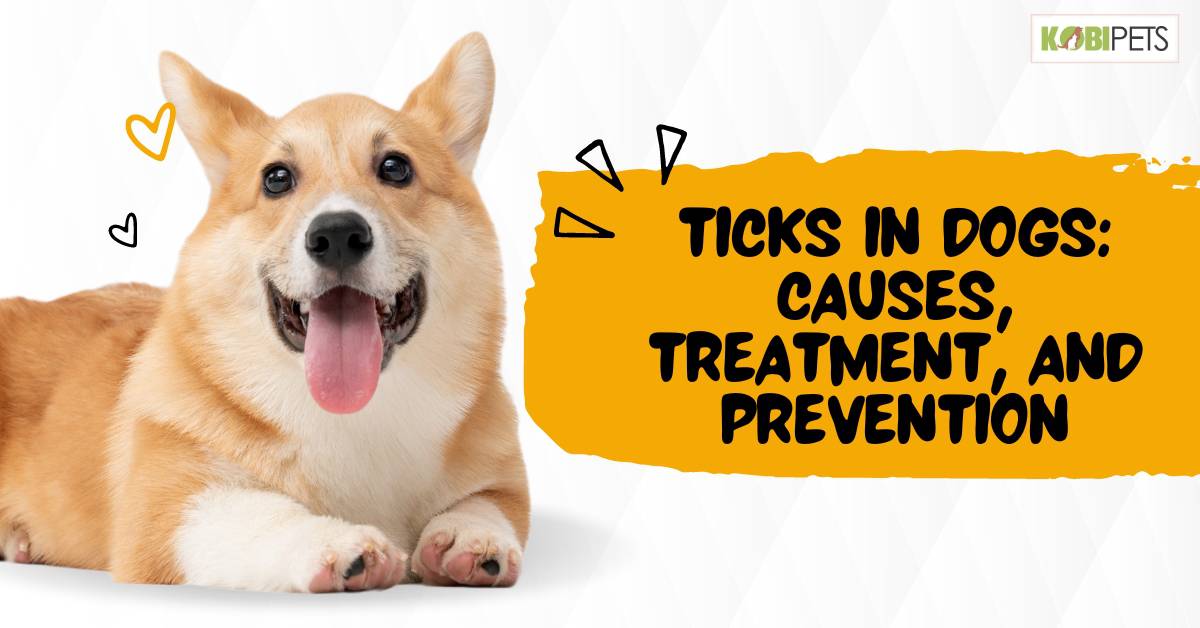
Are you worried about ticks on your beloved dog? Ticks can be a major annoyance and carry several diseases, but there are steps you can take to protect your furry friend. In this blog post, we’ll discuss the causes of ticks in dogs, treatment options, and how to prevent them from coming back.
We’ll also provide some tips for keeping your pup safe from ticks and other pests. By the end of this post, you’ll have a better understanding of how to keep your dog safe from ticks and what to do if you find one on your pet. So let’s get started!
Understanding Ticks and Their Impact on Dogs
Understanding ticks and their impact on dogs is important for both dog owners and veterinary professionals. Ticks are external parasites of animals and humans, capable of causing a variety of diseases in their hosts.
This can range from mild allergic reactions to life-threatening illnesses such as ehrlichiosis, anaplasmosis, Lyme disease, Rocky Mountain spotted fever, babesiosis, and more. Dogs are particularly vulnerable to tick-borne diseases due to their temperament and activities – they often enjoy going outdoors, exploring areas with tall grass or other vegetation which serve as prime living conditions for these bloodsucking parasites.
It’s important to understand the risk factors associated with ticks such as seasonality, time of year, geographic location, ectoparasite control, and preventive healthcare measures. That way you can protect your pup from any potential danger.

Causes of Ticks in Dogs
Ticks are commonly found in wooded areas or tall grass, and they can attach to a dog when they brush against these areas. Ticks can also be brought into the home on clothing or gear, such as hiking boots or camping equipment. Once a tick attaches to a dog, it will begin to feed on the dog’s blood, which can cause a variety of health problems.
Certain factors can increase the likelihood of a dog getting ticks, such as:
- Living in an area with a high tick population
- Not using tick preventatives
- Spending a lot of time outdoors
- Dogs with long hair or thick coats
- Brushing against wooded areas or tall grass
- Ticks brought into the home on clothing or gear
- Not checking for ticks regularly
- Some breeds are more susceptible to ticks than others
- Climate conditions are favorable for ticks to survive and thrive.
- Wild animals such as deer, raccoons, and other mammals, can carry and spread ticks.
It’s important to note that ticks can carry and transmit diseases to dogs such as Lyme disease, Anaplasmosis, Ehrlichiosis, and many others, so it’s important to be vigilant about tick prevention and to check your dog regularly for ticks if they spend a lot of time outdoors.

Treatment and Removal of Ticks from Dogs
Removing ticks from a dog as soon as possible is important to prevent tick-borne diseases and avoid further complications. Here are the steps you can take to remove a tick from your dog:
- Use a pair of fine-tipped tweezers or a tick removal tool to grasp the tick as close to the dog’s skin as possible.
- Pull the tick straight out without twisting or crushing it. If the tick’s head breaks off, it’s important to remove it as well.
- Clean the area of the tick bite with an antiseptic and apply a small amount of antibiotic ointment to prevent infection.
- Dispose of the tick by placing it in alcohol, or flushing it down the toilet.
- Keep an eye on the bite for any signs of infection such as redness, swelling, or discharge, and if any of these signs occur, seek veterinary care.
It’s important to keep in mind that using heat, petroleum jelly, or nail polish to remove ticks is not recommended as it can stress the tick and increase the risk of disease transmission. Also, it’s important to always check your dog for ticks after spending time in areas where they are known to be present and to consult a veterinarian if you notice any signs of illness after a tick bite.

Preventing Ticks on Dogs: Tips and Strategies
Keeping ticks off of your dog is important for protecting them from diseases like Lyme disease, Anaplasmosis, and Rocky Mountain spotted fever. There are several different strategies and tools available to help you prevent ticks on your pet.
Strategies
The best way to keep ticks from getting on your pet is to reduce the environments that support tick populations. Clean up any spilled bird seed or fallen fruit around the yard, and regularly mow long grasses and shrubs that provide shelter for the bugs.
You can also apply insect repellents specifically designed for use on animals; be sure to check with your veterinarian before using any products, as some may not be safe to use on certain breeds or ages of dogs. Lastly, regular brushing of your pet’s coat can help remove those tiny buggers before they can take hold.
Tools
There are a variety of products designed to assist in keeping ticks away from pets such as flea/tick collars, topical treatments applied once a month, spot-on treatments (dabbed between the shoulder blades), clothing items treated with anti-tick chemicals, or even a full-body suit equipped with zipper closures which look like pajamas for Fido!
Bathing your pet regularly with either insecticidal shampoos or natural options like vinegar and water will also help keep the little pests at bay.
In addition, keeping an eye out for signs of tick activity on your pet — such as small bumps near its head or body — and taking it in for regular check-ups at the vet will ensure early detection in case there is evidence of an infestation.

Tick-borne Diseases in Dogs: Signs and Symptoms
Dogs can become infected with tick-borne diseases, such as Lyme disease, Ehrlichiosis, and Anaplasmosis when bitten by an infected tick. It is important to be aware of the signs and symptoms that may indicate your pet has been exposed to one of these potentially life-threatening illnesses.
Signs and Symptoms
The most common signs of a tick-borne disease in dogs include:
- fever
- lethargy
- lameness or joint pain
- loss of appetite or weight loss
- coughing
- difficulty breathing
- enlarged lymph nodes or spleen
- swelling around joints and eyes
- seizures
- behavioral changes.
If left untreated for too long, these illnesses can cause serious organ damage that may even lead to death.
Diagnosis and Treatment
If you notice any of these signs in your pet and suspect it could be a tick-borne illness, it is important to take them to the vet right away for a diagnosis. They will run a series of tests (such as blood tests) to verify if they have been infected by a tick.
Once diagnosed, pets typically undergo treatment with antibiotics or other drugs specifically developed for these illnesses. It is important to follow all recommendations given by your vet during this time in order to ensure full recovery from the disease.

The Importance of Regular Tick Preventative Measures for Dogs
Regular prevention is a must for dogs when it comes to ticks. Ticks are a common problem in many areas and can spread a variety of dangerous diseases to our furry friends, both canine and human alike. To ensure your dog stays tick-free, invest in the necessary preventative measures such as flea collars and topical drops.
Not only do these products provide an extra layer of protection, but they also aid in creating an inhospitable environment for them to live within. If your dog has recently been exposed to a high-risk area, consider using more extreme methods such as routine washes with tick-repellent shampoo or powders that target the ticks on contact.
Each product should always be used under the supervision of a veterinarian to ensure the safety and effectiveness of your pup. Taking the time for these precautionary steps will help keep you, your family, and your four-legged companion healthy and safe from any menacing parasites.

In Conclusion
Ticks on dogs can be a major annoyance and carry several diseases. It is important to take steps to protect your pup from these pesky pests by understanding the risk factors associated with ticks, checking for ticks regularly, removing them as soon as possible, using preventative measures such as flea collars and topical drops, and consulting a veterinarian if you notice any signs of illness after a tick bite.
Taking the time for these precautionary steps will keep both you and your pet safe from any potential dangers associated with ticks. By following these tips, you can help ensure your pup stays happy, healthy, and free from tick-borne diseases!






